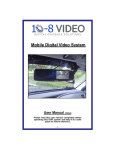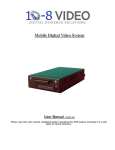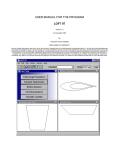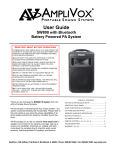Download 10-8 In-Car Video System - 10
Transcript
10-8 In-Car Video System Installation / User Manual 2011r1 Warranty & Return Information All Products • Three (3) year free replacement of any failed component. No RMA required. Car Camera Components 1. Call 1-888-788-1048 and ask for Technical Support. 2. We will then mail a new component via USPS Priority Mail within one (1) business day. 3. When you receive the replacement, mail back the failed component. Shipping Address Copyright © 2011 10-8 Video Digital Evidence Solutions. • All rights reserved. Disclaimer: 10-8 Video Digital Evidence Solutions reserves the right to make changes in specifications at any time and without notice. The information provided by this document is believed to be accurate and reliable. However, no responsibility is assumed by 10-8 Video Digital Evidence Solutions for its use; nor any infringements of patents or other rights of third parties resulting from its use. No license is granted under any patents or patent rights of 10-8 Video Digital Evidence Solutions. Other company and product names mentioned herein may be trademarks of their respective companies. 10-8 Video Digital Evidence Solutions 301 Market Street. E. #F Fayetteville, TN 37334 Phone Numbers (888) 788-1048 • (931) 262-2221 (931) 233-1263 (FAX) 10-8 Digital Video Evidence Solutions 301 Market Street. E. #F Fayetteville, TN 37334 Tel: (888) 788-1048 • (931) 262-2221 Fax: (931) 233-1263 World Wide Web: www.10-8Video.com 2 3 Contents CD-ROM Instructions Manuals Safety 9 9 10 Daily Operation 10 Package Contents 12 System Schematic 14 Hardware: Installation 15 Introduction Digital Video Recorder Unit (DVR) Common Installation Areas Emergency Lights & Manual Activation 2.4GHZ Wireless Mic Brown Wire (Trigger REC) Trigger REC DVR Set-up Black Wire (Audio Out) 2.4GHZ Mic Antenna UHF Wireless Mic Single System Setup Automatic Frequency Selection Automatic Transmitter Setup PGX1 Bodypack Transmitter Wearing the Bodypack Transmitter Changing the Bodypack Transmitter Batteries Mirror Monitor Camera Mount Front Camera Rear Camera G-Force Sensor 4 15 16 16 18 20 20 21 21 23 24 26 26 27 28 29 29 30 32 34 36 37 GPS System Setting the GPS Speed Trigger 37 37 Hardware: Configuration 38 DVR Configuration Entering Your Unit ID Setting Date and Time G-Force Sensor Configuration 38 39 40 41 Hardware: Usage 42 In-Car Playback Watch Previously Recorded Events Viewing Today’s Recordings Viewing Another Day’s Recordings Stopping Playback DVR Remote Control Entering Your Unit/Car ID Camera Adjustment Wireless Mic – 2.4GHZ Syncing Transmitter and Cradle Transmitting Audio Mode Button Microphone Wireless Mic - UHF 42 42 42 43 43 44 44 45 46 46 46 47 47 48 Software: Installation 49 Software Installation 49 Software: Introduction 50 Software Overview 50 Software: Usage 52 Opening A File 52 5 Contents Searching For A File Playing A File Adjusting Playback Speed Adjusting Playback Volume Maximizing the View of a Video Clip Stopping Playback Monitoring G-Force and Speed Events Using the Google™ GPS Window Saving a Snapshot Exporting Events to a Video File Maintaining Evidence Integrity Exported File Format Steps to Export Video Export Options Exporting an Event Report Software Settings System Parameters Map Parameters Video Parameters File Associations Archiving Video Tips Appendix A GMT Time Zones - United States 6 Contents 53 54 54 54 54 55 55 56 56 57 57 57 57 57 59 60 60 60 60 61 62 This page left intentionally blank. 64 64 Contents 7 CD-ROM CD-ROM Instructions The CD at left contains the viewer software needed for playback on your computer. It also includes PDF copies of all manuals. When you insert the CD it will automatically run the software installation program Manuals To access the manuals: 1 2 CD-ROM 8 3 Insert the CD into your CD-ROM/DVD drive. When the installation program launches, click Cancel at the install prompt. You can then access the files on the CD through your file manager like you would any other CD. 9 Safety Daily Operation You, as the driver, are solely responsible for the safe operation of your vehicle and the safety of your passengers according to the US and local traffic regulations. WARNING: Do not use any features of this system to the extent it distracts you from safe driving. Your first priority while driving should always be the safe operation of your vehicle. 10-8 Video cannot accept any responsibility whatsoever for accidents resulting from failure to observe these precautions or safety instructions: WARNING: This product utilizes high voltage. Any unauthorized modifications or damage to the products may result in electrical shock. 1. Handle all components with care. Inspect regularly for damage to components and cabling. Excessive force used before, during or after installation that results in a damaged or non-functional part shall void all warranties. Improper installation or modification of this product shall void all warranties. 2. You are responsible to ensure that the installation of this product does not void or affect the vehicle manufacturer’s warranty. 10-8 Video, or its branches are not liable in full or in part for improper installation resulting in loss or damage to your property, or for voiding all or part of the vehicle manufacturer’s warranty. 3. Do not apply excessive force to any of the components contained within this kit. 4. Please follow the procedures from this installation manual. 10 11 Package Contents HARNESSES (Simplified for clairity) Power Harness A/V Harness Sensor Harness 2.4GHZ Harness Mirror Harness Video Harness 2 REC ALM SD1 IR PWR GPS SD2 Camera* & Mount Mirror Digital Video Recorder (DVR) Wireless Mic (Optional) 2.4GHZ model shown. Camera Harness GPS Unit (Optional) * NOTE: Actual camera appearance may vary from illustration. 12 13 System Schematic Hardware: Installation Introduction The installation of the 10-8 Patrol Car video system breaks down to some very simple steps. The basic connection for video and audio are very similar to a VCR or DVD player. The one area that differs from what you may have done in the past is the connections for the alarm inputs . There are four (4) sensor wires that will activate the recorder anytime voltage is applied to any of the four (4) wires. GPS 6 Pin Power Harness To help make the connections easier, the cables that attach to the back of the DVR each use a different type of connector. Familiarize yourself with the inputs in the picture on pages 10 and 11. 4 Pin A/V Harness You will need a single 12 volt power source for the system with just one (1) power and one (1) ground source needed. RED: Vehicle +12V “Ignition on” BLACK: Vehicle Chassis Ground BLACK (PWR GND) to ground RED (PWR) to +12V Sensor 2 Out Sensor 3 In Sensor 4 In Sensor 1 Out Trigger Wire (Trigger REC) - Brown Sensor 1 In Sensor 2 In GPS Fuse We strongly recommend that the power source be from switched power that is only hot when the vehicle key is in the ‘ON’ position. This should be a five (5) amp fused power source. To eliminate interference, there should be no other equipment on this circuit. It is also very important that the ground be a good chassis ground source and not tied into the ground of other equipment. When the DVR’s door is unlocked to allow access to the SD cards the system is automatically powered down to protect the files on the SD cards. When the door is locked, the DVR system will be able to accept power and turn on again. CAT 5 NOTE: Actual camera appearance may vary from illustration. 14 15 Hardware: Installation Digital Video Recorder Unit (DVR) The first thing you will want to do is locate where you want to install the DVR. The small size of the unit makes that much easier than just a few short years ago. Common Installation Areas • Main equipment console • Either side of the console GPS • In the dash • Under the dash. Try to keep the unit in sight of the driver where they will be able to use the I/R remote more easily. If needed, the DVR ships with brackets for mounting. 1 Insert the Red/Black 6-pin Power Harness Connector into power receptacle in rear of DVR unit making sure it locks into place. 2 3 4 5 6 7 Connect BLACK lead to a chassis ground. Connect RED lead to 12 volt ‘ignition on’ power source. Connect Sensor Harness to back of DVR. Connect 4-pin A/V Harness to back of DVR. 6 Pin Power Harness 1 4 Pin AV Harness Sensor Harness 5 6 4 RED: Vehicle +12 v “Ignition on” GPS Camera Harness 7 GPS BLACK: Vehicle Chassis Ground FIG. 1 Connecting Harnesses to DVR Connect GPS Cable Connector to back of DVR. Connect Camera Harness to back of DVR. Tighten connector nut to secure harness. 16 DVR Installation 17 Hardware: Installation Emergency Lights & Manual Activation There are four (4) wires (leads) coming from the sensor harness. Each wire will activate the recorder when voltage is applied to any single wire. In a typical patrol car installation, 2 of these wires will be used. These wires will detect when voltage is present and activate the recorder. Sensor Wire 1 1 Connect one wire to the output side of your control box for your pursuit lights. You can connect it to any of the lights that are used for emergency traffic. This way the recorder will start anytime you are running emergency traffic. Depending on the type of switch box used, there may be a place to connect at the back of the switch box. If not, simply connect to any wire that goes to a 12v light that is activated when you turn on the emergency/pursuit lights. Sensor Wire 2 2 Caution: These wires are very sensitive and care must be taken that you do not connect to a wire that has low voltage all the time, as the recorder will detect voltage and activate the recorder. Connect the second wire to a manual switch that you will activate when you want to start the recorder without lights activated. Sensor 3 - to brown wire of 2.4Ghz Mic Sensor 2 - to manual switch Sensor 1 - to pursuit lights FIG. 2 Sensor Harness You can use any switch of your choosing that will provide 12v to the wire. Many control boxes in use today will have a blank switch that is not being used. These are a great choice for the manual switch. If none are available, a simple toggle or rocker switch mounted in a convenient location works well. 18 Emergency Lights & Manual Activation Installation 19 Hardware: Installation 2.4GHZ Wireless Mic If your department opted for our new 2.4ghz wireless microphone system, congratulations! This is an incredible wireless microphone with excellent range and clarity. The installation is easy and straight forward. 1 Find a suitable place in the vehicle for the base station/receiver. A bracket is included. It should be mounted in an easily accessible position. Be sure there is room to easily insert and remove the transmitter in the cradle. 2 3 Connect the RED wire (labeled PWR) to a positive 12v source. Connect the BLACK wire (labeled PWR GND) to a ground. All of the wires are labeled from the factory. For this installation, there are 3 wires that will not be used for this installation: • • • a white wire labeled ‘Mute Indication’ a black wire labeled ‘Trigger Gnd’ an orange wire labeled ‘ TX indication’. These wire can be cut or tucked away. Brown Wire (Trigger REC) One wire’s use is optional; the small brown wire labeled ‘ Trigger REC’. If this wire is connected to the Sensor #3 lead from the back of the DVR (FIG 2), then the DVR will begin recording when the talk button on transmitter is active and lit. In other words, if an officer keeps their mic on stand-by when not in use, then when they activate with the ‘talk’ button to begin transmitting it will activate the recorder. This is useful when outside the car and not recording, and then a situation comes up and the officer needs to activate the recorder remotely to begin recording. This is only optional and should be left up to the department or officer of the vehicle. 20 If you hooked up the brown trigger lead to the DVR for remote activation, there is one setting that needs changed in the DVR: Trigger REC DVR Set-up 1 2 3 4 5 6 7 8 9 Power on the system. Press the ‘Login’ key on the remote. Use the arrow keys to select ‘Vehicle’. Select ‘Sensor’. On the next screen on the 3rd Sensor line, Under Enable, change to ‘ON’ Change Pwr to ‘Low’. Change Rec to ‘ON’. Change Alarm to ‘ON’. Scroll down to ‘Save’ and select to save the changes. Black Wire (Audio Out) 1 Plug the male RCA plug into the female red RCA plug coming from the camera wire harness. (FIG 3) 2.4GHZ Wireless Mic Installation 21 CAM PWR to DVR CAM1 2.4GHZ Mic Antenna 1 2 3 Plug the antenna into the gold plug on the top of the cradle. Secure by tightening the lock nut. Run the wire down under the dash or other hidden location, somewhere toward the front of the vehicle. Velcro or double-sided tape works great for securing the antennae end to a flat surface on the vehicle. Audio Out male RCA female RCA Fuse Trigger Wire (Trigger REC) - Brown RED (PWR) to +12V Sensor 2 Out BLACK (PWR GND) to ground Sensor 3 In Sensor 4 In Sensor 1 Out Sensor 1 In - (Brown) Sensor 2 In CAM signal Hardware: Installation CAT 5 FIG. 3 2.4GHZ Wireless Mic Installation 22 2.4GHZ Wireless Mic Installation 2.4GHZ Wireless Mic Installation 23 Hardware: Installation UHF Wireless Mic 1 Locate a convenient spot for the wireless mic receiver (the small box with the collapsible antennas). The location does not have to be readily accessible once it is installed so you may want to put it under a seat, or under the dash Since it is so small and light, just Velcro it to the firewall or anywhere else that is convenient for you. 1 It is recommended that it be in the front half of the vehicle for the best reception. 2 3 2 Plug in the power lead to one of the available power leads on the DVR power harness. 3 Locate the audio cable - the black cable in your kit that has a male phono plug on one end and red RCA on the other. 4 Plug the phono plug into the 1/4” unbalanced output jack on the back of the wireless receiver (#4 - FIG 5). 5 6 Mount the wireless receiver. Audio LED Indicates strength of incoming audio signal: green = Normal, amber = Strong, red = Peak. LED screen See “Single System Setup” page 24. Channel Button See “Single System Setup” page 24. 4 5 6 Ready LED Green light indicates system is ready for use. Infrared (IR) Port Broadcasts IR signal to transmitter. Sync Button Press to synchronize transmitter and reciever frequencies. FIG. 4 UHF Wireless Receiver - FRONT Plug the RCA plug end of the audio cable into the red RCA plug of the Audio/Video input cable from the back of the DVR. Be sure to read the wireless mic section on syncing the transmitter and receiver. If installing systems in more than one vehicle, set the frequencies two to four channels apart to allow more than one system in the same area without interference. 24 1 2 AC Adapter Jack Adapter Cord Tie-off 3 4 XLR Balanced Mic Output Jack (not used) 1/4” Unbalanced Output Jack FIG. 5 UHF Wireless Receiver - BACK UHF Wireless Mic Installation 25 Hardware: Installation Single System Setup Automatic Transmitter Setup In any wireless setup, each transmitter and receiver pair must be tuned to the same frequency, or channel. The 10-8 wireless system uses automatic transmitter setup to synchronize the transmitter and receiver channels. 1 2 Turn ON the transmitter. 3 4 Expose the transmitter IR port to the receiver. (FIG. 7) Automatic Frequency Selection 1 Press and release the channel button. (FIG. 6) This scans for a clear channel and sets the receiver to that channel. LED screen displays Press channel button to scan current channel for a clear channel System scans for clearest available channel FIG. 6 Frequency Selection 2 Proceed to Automatic Transmitter Setup on the next page. 26 UHF Wireless Mic Installation 5 6 Open the transmitter battery compartment to display the infrared (IR) port. (See page 28) Press and hold the sync button on the receiver until the red light stops flashing on both the receiver and transmitter. (FIG. 7) FIG. 7 Syncing the Transmitter and Receiver When the receiver’s ready light glows, the system is ready for use. Close the transmitter’s battery compartment. UHF Wireless Mic Installation 27 Hardware: Installation PGX1 Bodypack Transmitter Wearing the Bodypack Transmitter Clip the transmitter to a belt 1 or slide through the transmitter clip 2 as shown. If using a belt, slide the transmitter until the belt is pressed against the base of the clip. Changing the Bodypack Transmitter Batteries •Expected life for alkaline batteries is approximately eight (8) hours. •When the transmitter light glows red, the batteries should be replaced immediately, as illustrated. FIG. 8 1 Power / Infrared (IR) / Mute Indicator Color & State Meaning Amber, Solid Mute on. Green, Solid Ready. Green, Flashing Red, Solid Red, Flashing Red, Pulsing on startup Red, Pulsing after Sync. Controls locked. Battery power low. (Transmitter cannot be turned off until batteries are changed) IR transmission in process. Batteries dead. (Transmitter cannot be turned on until batteries are changed) Transmitter and receiver are incompatible; contact 10-8 Video 2 On-Off / Mute Switch Press and hold to turn on or off. Press and Release to mute or un-mute. 3 4-Pin Microphone Input Jack 4 Infrared (IR) Port Receives infrared beam to synchronize frequencies. When using multiple systems, only one transmitter IR port should be exposed at a time. 5 Gain Adjustment Switch 28 UHF Wireless Mic Installation UHF Wireless Mic Installation 29 Hardware: Installation Mirror Monitor 1 Mount the mirror/monitor over the existing mirror. 2 Run wires to DVR. 4 Pin A/V Harness (to DVR) A good place to run the wires for the mirror is to tuck them in the front edge of the headliner and down the passenger side pillar post. The covers on most modern pillar posts snap in to place and are easily removed with plenty of room. 3 Run the wires down along the door edge and under the glove box to the location of the DVR. 4 Connect the power lead to one of the available power leads on the DVR power harness. 5 Plug the yellow RCA connector labeled ‘Video1’ to the yellow RCA female connection of the 2 leads coming from the A/V Output port. Yellow RCA (Female) Yellow RCA (Male) Power (Male) Power (Female) Video (Female) Video (Male) The red audio out is generally not used as audio playback is not usually needed in the vehicle. If you wish to use the audio out, you will need to connect to a powered speaker with volume control. FIG. 9 Mirror Installation 30 Mirror Installation 31 Hardware: Installation Camera Mount The mount is an excellent commercial mount and is very strong when properly attached to the windshield. 1 1 Locate the mounting location of the camera - high and just right of center on the windshield. Press in button. This is normally to the rear and slightly to the right of the rear view mirror/monitor. Leave just enough room for the camera to rotate 180 degrees in either direction. 2 3 2 Pull lever over button. Clean the glass where the mount is to be placed. Press in on the center button of the mount and pull the locking lever up and over the center button to lock it in place. 3 Locked position. 32 Camera Mount Installation 33 Hardware: Installation Front Camera 1 Run the included cable along side the mirror/monitor cable to the DVR. 2 Plug the BNC video connector from the camera to the BNC video-in cable from the DVR. 3 Connect the power lead to one of the available power leads on the DVR power harness. 4 Adjust the large locking wheel (FIG. 10) above the camera so that the camera can be rotated easily, yet stay in place while driving. Power BNC Hold the camera firmly while adjusting the wheel. (Male) (Female) BNC Power (Female) (Male) BNC Power BNC Power (Female) (Male) (Female) (Male) Video (Male) TO DVR RCA (Female) Locking Wheel FIG. 10 Front Camera* Mount System 34 FIG. 11 Front Camera Installation * NOTE: Actual camera appearance may vary from illustration. 35 Hardware: Installation Rear Camera The 10-8 rear camera is a true Day/Nite camera with automatic infrared and B/W functions. It also features an integrated microphone to capture sounds and conversations in the interior of the vehicle. Mounting options for this camera will vary greatly from vehicle to vehicle and will depend on type of vehicle and if there is a rear divider in the vehicle. The camera is supplied with a fully articulating universal mount. The location of the camera should give the best view of the rear/ transport area of the vehicle. If the vehicle has a cage, we suggest the camera be mounted high as possible and to one side pointing across the rear area to be viewed. If there is no cage, another choice would be high in the center of the vehicle in the front and pointing rearward, mounting just to the rear of the windshield. Once a location has been found, run the supplied cable from the camera to the DVR. The cable will differ from the front camera as there are three (3) connections on each end instead of two (2). This 3rd connection is for the built in microphone. Connect the cable to the ‘Rear Cam’ section at the rear of the DVR. IMPORTANT: The ball mount on the rear camera has been attached at the factory. Do not attempt to tighten further. If necessary to remove and re-attach, the ball mount should be tightened only to the point where it stops in the bottom of the camera. 36 G-Force Sensor The G-Force sensor is integrated into the DVR and configured at the factory. GPS System The GPS Antennae can be mounted in or outside of the vehicle, as long as it has a clear view of the sky. The magnet backing is very strong for mounting on the roof. It can also be mounted in the vehicle, under the windshield. 1 2 Mount the antennae. Route the cable back to the DVR and attach to the port labeled GPS. The GPS receiver will display your vehicle speed and coordinates at all time on the system monitor. In addition, GPS coordinates are imbedded in all recordings made on the system. During playback on a computer, the user can elect to display a map show the actual location of the vehicle as the video is played. As long as the vehicle is in a location with a clear view of the sky and GPS satellites, you will get a reading from the GPS receiver. Setting the GPS Speed Trigger Locate the GPS settings by going to Menu > Vehicle > Speed. The only option you will want to change is the speed option. It is preset to 80 MPH. When the vehicle is travelling at a rate greater than this setting, the DVR will begin to record and record as long as the vehicle is over this speed setting. 37 Hardware: Configuration DVR Configuration 1 Insure the SD card(s) are properly inserted in the DVR unit. Slot 1 should be used first as it is the primary slot. The additional slot is for extra storage. Each slot can accept a card up to 32GB. This gives the system a total capacity of 64GB. (2 x 32GB = 64GB) 2 Start the car or turn the key to the accessory position to power up the system. 3 Wait a few moments and the system will come on and go through a brief self test. 4 Align the camera for the proper view. We recommend a slightly right of center view. This allows for a centered view of a vehicle during a traffic stop if you use a left offset during your stops. Entering Your Unit ID 1 2 3 4 5 6 7 38 Press ‘Menu’ on the remote. (FIG. 13) Use the arrow button to scroll down and select ‘System’. Press the ‘Enter’ button (the button between the arrows on the remote). Select ‘Basic’ and press the ‘Enter’ button. You will be prompted by a login screen. Enter the proper user and password. If an administrator username and password has not been defined, use the defaults: username: admin password: 111111 Scroll to the Vehicle ID section. Enter your unit or badge number. This is the ID that will be displayed in recordings to identify which unit made the recording. Up to 8 characters can be used here. Press the ‘Save’ button when done to save your changes. DVR Configuration 39 Hardware: Configuration Setting Date and Time 1 2 3 4 Press ‘Menu’ on the remote. (FIG. 13) Use the arrow buttons to scroll down and select ‘System’. Scroll and select ‘Basic’. You will be prompted by a login screen. Enter the proper user and password. 5 Use the arrow buttons to scroll down to each section that you need to change. 6 7 Highlight the area to be changed and press OK button. 8 Change values with +/- keys and press OK again to accept. The autotiming feature uses the GPS system to automatically sync the system time. The ‘Timing Time’ is the time of day that the system performs the sync each day. For the autotiming feature to work properly, make sure to properly set the time zone value. See Appendix A for a time zone chart. G-Force Sensor Configuration The G-Force sensor is integrated into the DVR and configured at the factory. 1 2 3 Power up the system. Locate the menu section and select ‘Vehicle’. Find the line labeled ‘G sensor’. We recommend a setting of 2-2.5g. As you decrease this setting the G sensor will be more sensitive. This sensor will activate the recorder when the vehicle experiences an impact or jolt that is above the setting the sensor is set at. It will continue to record for approximately 30 seconds after impact. Along with the 30 second pre-record of the recorder, this will give you a recording of approximately 1 minute. Note that the G-Force sensor can be configured separately for each axis of movement of the vehicle. For best results, set each axis to the same value. When everything is set for your location, choose the ‘save’ button on the screen and press the ‘Enter’ button on the remote. FIG. 12 G-Force Vehicle Axis 40 DVR Configuration 41 Hardware: Usage In-Car Playback Your video will begin to play and using the remote you can Fast Forward, Fast Rewind or Pause the playback. Watch Previously Recorded Events Viewing Another Day’s Recordings If you are currently recording an event, you can still playback an event without interrupting the recording. 1 2 3 1 Use the calendar feature at the top of the Playback screen or use the search form to specify the day. 2 Select the ‘Search’ button on the screen and press the ‘Enter’ remote button. 3 A list of events that have been recorded starting with the latest at the top will display. 4 5 Use the arrow buttons to select the event you wish to watch. Point the remote at the DVR and press the ‘Menu’ button. Choose the ‘Playback’ icon. Press the ‘Enter’ button on the remote. You will be presented with a screen showing a calendar and search features. This screen will automatically default to the recordings for the current day. Viewing Today’s Recordings When you enter the Playback menu the system automatically defaults to today’s recordings. 1 2 3 After the Playback screen loads, select the ‘Search’ button on the screen. 4 5 Use the arrow buttons to select the event you wish to watch. Press the ‘Enter’ button. Stopping Playback 1 Press the ‘Stop’ button to return to the event list. Press the ‘Enter’ remote button. A list of events that have been recorded starting with the latest at the top will display. If there are more than one page of events, the right & left buttons will turn the page to reveal more events. Press the ‘Enter’ button. 42 In-Car Playback 43 Hardware: Usage DVR Remote Control Camera Adjustment There is a large wing-nut (FIG. 14) on the side of the camera mount that allows you to align the camera as needed. This adjustment should only be tightened enough to hold the camera in place while driving, but loose enough to allow the camera to be swivelled or moved as needed. Up 2 Adjustment Wing-nut * NOTE: Actual camera appearance may vary from illustration. FIG. 13 DVR Remote FIG. 14 Camera* Adjustment Wing-nut Entering Your Unit/Car ID See “Entering Your Unit ID” on page 39. 44 45 Hardware: Usage Wireless Mic – 2.4GHZ If your department opted for our new 2.4GHZ wireless microphone system, congratulations. This is an incredible wireless microphone with excellent range and clarity. The operation is easy and straight forward. Transmitting LED Indicates transmitting status. 2 Battery/Syncing LED Battery status and syncing status. 1 Transmitter and Cradle • As long as there is power to the cradle/receiver, and the transmitter is inserted properly in the cradle, the transmitter will charge and stay charged. • Inserting the transmitter into the cradle will synch the frequency and channel between the transmitter and receiver. 1 2 3 Talk Button 4 Mode Button 5 Mute Button 6 External Mic. Jack 7 Internal Mic. 8 ON/OFF Switch • When the ‘green’ LED light is solid, the battery is charged. Syncing Transmitter and Cradle 1 Slide the small switch on the bottom of the transmitter to the ‘ON’ position. 2 Insert the transmitter into the cradle to allow the units to synch. 3 When the transmitter is ready for use, the ‘Talk’ light will flash briefly. 3 4 FIG. 15 2.4 GHZ Wireless Mic System Pressing the red ‘Talk’ button switches the unit between stand-by and actively transmitting. Pressing the button again will put the transmitter in stand-by and turn the recorder off. The exception to this would be if the recorder was already activated by your emergency equipment. In this case, the recorder would continue to record but your mic transmitter would be in stand-by and not transmitting audio to the recorder. 46 8 6 7 Transmitting Audio If your receiver was installed with the transmit sensor connected to the DVR, then activating the transmitter with the ‘talk’ button will also activate the recorder to begin recording. 5 Mode Button The Mode button cycles through 3 modes: silent, vibrate & audio warning, and vibrate only. This is for instances when your Mic is out of range to the receiver or has not been properly synched to the receiver. Microphone This unit has a built in microphone in the transmitter. For most situations, this is the only microphone you will need. However, the unit is also supplied with a wired lapel microphone. Should this mic be needed, simply plug the microphone into the top of the transmitter. This will de-activate the built in mic and audio will only be picked up by the wired mic. Wireless Mic - 2.4GHZ 47 Hardware: Usage Wireless Mic - UHF The wireless microphone provided with your system provides excellent range and clarity, even while inside a building. The belt pack transmitter uses 2 AA batteries and has incredible battery life. It is the only system we have found that has an approximate 20hr battery life, as opposed to 4-6 hrs with most systems. We recommend rechargeable AA batteries and charger be purchased from most any electronic/department store. A 4 battery system with batteries and charger can generally be found for $10-15. At the end of each shift you can simply place the batteries in the charger when you charge your walkie. Software: Installation Software Installation Install the 10-8 Player software by running the CD supplied with your system. If the CD is not available, you may download the player software from the 10-8 Video web site: http://www.10-8video.com/ The player software will associate any files with the extension “.264” with itself. This will allow your to launch the player and automatically load a video file by double clicking the file’s name/icon in Windows® Explorer. Because of the long battery life, you can simply turn the transmitter on at the start of a shift and leave it on for the entire shift. The audio will only record when the unit is activated, but it will prevent you from missing critical audio when something comes up and you forget to turn it on. If needed, it could of course be turned off should you not want audio to record. The belt pack transmitter can be clipped to your belt or carried in a pocket. If you wish to put it in a pocket, you can fold the antennae to one side so that a pocket flap will close. You can then clip the microphone to a pocket or remove the clip on the microphone and place the microphone inside a pocket fold. 48 49 Software: Introduction Software Overview Use the screen capture at right to familiarize yourself with the software interface. 1 2 3 4 5 6 File Lists Tab Displays all of the clips in the currently selected folder. Event List Tab Displays all of the events in the currently selected folder. Search Tab Opens up a Windows® file browser window to allow you to select the folder or files to review. Tabs Display Will show Files List or Events List depending upon which tab is selected. G-Force Graph 8 Playback Speed 9 Playback Volume 10 Playback Timeline 11 Stop Playback 12 Play 13 Maximize Currently Selected Video 14 Single Window Display 15 Four Window Display 16 Take a Screen Shot. 17 Export Video 18 Generate a Report This allows you to generate a more detailed report with screen shots, a Google™ map and notes. Software Settings A Google™ Maps Display When GPS coordinates have been recorded with the video file being played, the map will display the path of the vehicle. An active internet connection is required for this to function. Date and Time of Recording B Unit ID/Badge Number C GPS Coordinates at Time of Recording 20 B Camera 1 Video Clip Displays the video from camera 1. When this window or any of the video clip windows are double-clicked they will re-size to take up the entire video clip window area. Camera 2 Video Clip 7 19 A 50 C 3 4 5 6 1 2 20 7 8 9 10 11 12 13 14 15 16 17 18 19 FIG. 16 Software Player Software Overview 51 Software: Usage Opening A File Searching For A File 1 2 3 4 5 6 1 2 3 You can read files from either your hard drive, an SD Card or other external media. Click on the ‘Search Tab’ (#5 - FIG 16). Click on ‘Open Folder’. The standard Microsoft Windows® file dialog window will appear. You can search for files via their creation date and time, physical location and event type. Click on the ‘OK’ button. 8 Double click on one of the listed files to load it into the main window. A dialog box will appear that allows you to narrow your search: Date: Enter a specific date in the following format: YYYY-MM-DD All of the available files in the selected folder will appear in the Tabs Display (#6 - Fig 16) Click once on the one of the files listed in the Tabs Display to see a preview in the right column. Click on ‘Find File’. Path: Define the physical location to search for files. You can narrow your search to a specific computer drive. Browse to the folder location of your file(s). 7 Click on the ‘Search Tab’ (#5 - FIG 16). Begin: The beginning time of the event. End: The ending time of the event. Select Event Type: Choose the type of event to narrow your search. 4 52 Click ‘OK’ to begin your search. 53 Software: Usage Playing A File The 10-8 Video player software is designed to be easy to use. If you have ever played a video file on a computer, then you’ll feel right at ease using our software. You can speed up, slow down, and view your videos frame by frame. You can also use the Playback Slider (#1 - FIG 17) under the video to quickly go forward or backward in the video. Stopping Playback Click on the ‘Stop’ icon. (#4 - FIG 17). Monitoring G-Force and Speed Events The Event Monitor (#7 - FIG 17) will graph and display any changes in the vehicle’s G-Force along each axis (X,Y & Z) and the vehicle’s speed in MPG & KPH during the recording. Adjusting Playback Speed By adjusting the position of the Playback Speed Slider (#2 - FIG 17), you can play back the video at a faster or slower rate than it was originally recorded. Speeds ranged from 16 times slower to 16 times faster then normal speed. Adjusting Playback Volume Use the Playback Volume Slider (#3 - FIG 17) to adjust the playback volume of the video file. 6 The software will playback the volume of the currently selected camera. For example, clicking once on the upper left screen will enable the sound for that video clip. Clicking once on the top right window will enable the sound for that video clip. Maximizing the View of a Video Clip To enlarge a video clip to full screen you can either: • Double click on the video window (#6 - FIG 17) you wish to enlarge. Double clicking on the maximized window will reduce it to its original size. or • Click once on the screen you want to enlarge and then click on the ‘Maximize” icon (#5 - FIG 17). 54 7 2 1 3 4 5 8 9 10 11 FIG. 17 Software Player Playing a File 55 Software: Usage Using the Google™ GPS Window The Google™ map window behaves exactly like the maps located on Google’s web site. Using your mouse, you can click and drag the moving the focus/center point of the map. The +/- buttons on the map will allow you to zoom in or out as needed. The vehicle icon on the map will move along with the video you are playing. This map and icon will display the exact positions of the vehicle that made the recording. The text box that follows the vehicle icon on the screen is displaying the date and time along with the speed of the vehicle at the time of the recording. Your computer must have access to the internet to use this feature, as the map data is pulled from the Google™ servers in real time. Saving a Snapshot Exporting a screen shot is easy. All screen shots are exported to JPG files - readable by every modern computer and many “Smart” devices like the iPhone®. 1 Use either the ‘Play’ button or Playback Slider (#1 - FIG 17) to specify where in the video file you want to take a snapshot. 2 3 4 Click once on the window you want to capture. Click on the ‘Snapshot’ icon. (#8 - FIG 17). A standard Windows® dialog box will pop up allowing to you name the file to be saved and specify the location to save the file. 56 Exporting Events to a Video File Maintaining Evidence Integrity Before discussing the ways you can save an individual event, it is important to understand how the file will be used later. If you are saving an event for court, it is highly recommended that you use the original files. The reason for this is that the 10-8 System records video in a proprietary format. This is done to maintain evidence integrity. There is no commercially available software to manipulate the videos in any way and this is the reason you want to keep videos in their original format Exported File Format If you do not have a need to maintain evidence integrity, you can export the videos into the standard AVI file format using the MP4 file compression codec. Steps to Export 1 2 Click on the ‘AVI’ icon (#9 - FIG 17). 3 Click the ‘Start’ button to begin the conversion. A dialog window will pop up with the options to export the video file(s). You can alter these options to fit your needs. Video Export Options File: Allows you to select the specific files/camera clips to export to a single file. Check the boxes you wish to export. File Time: Timestamp of the created file. Time Range: Set the beginning time and ending time of the exported clip. This will allow you to create a clip of a specific event from a larger time frame. 57 Software: Usage Select Audio: Select which of the available video clip(s)’ audio tracks to export. Since the exported video can contain more than one video window but only one audio track, you need to choose the primary audio track to use for the entire exported video clip. The audio channel number corresponds to the channel number in the file box at the top of the dialog window. Progress and Start Button This is the progress bar that will display the overall progress of the exporting process. Clicking the start button begins the export process. Output (Change & Open) Clicking the ‘Change’ button will allow you to specify where the final exported video clip will be saved. This location defaults to the installation location of the player itself. Exporting an Event Report You can export an event report which will allow you to create a printed detailed page of a specific moment in a video recording. You can generate as many of these reports as needed. 1 Set the player to display the exact moment for which you want to generate a report. 2 3 4 Click on the ‘Report’ icon (#10 - FIG 17). Fill out any notes that you wish to add. Click the ‘Print’ button to print the report. Clicking the ‘Open’ button will open a Windows® Explorer window displaying the contents of the selected location. Target: Final location and filename of the exported file. Clicking the ‘Open’ button will open the exported file using your system’s default video player. 58 Exporting Events to a Video File 59 Software: Usage Software Settings File Associations The player settings can be accessed by clicking on the ‘Settings’ icon (#11 - FIG 17). Make sure to click ‘OK’ at the bottom of the window when done to save your changes. .264 Checking this box will associate all .264 video files on the computer to automatically open with the 10-8 Video Player. Selecting this option is recommended. System Parameters .AVI Checking this box will associate all .AVI video files on the computer to automatically open with the 10-8 Video Player. Language Set the language used in the program’s interface. Windows Set the default number of video clip windows displayed when the program opens. Map Parameters Show GPS Track Enable the display of the path of the vehicle on the GPS map. Video Parameters Watermark Verify Will determine video is original/unedited. Use RGB16 Not needed for modern computers. Enable this for older 16bit color systems. Overlay Driver and Company Select whether or not to display the driver ID and company information. Position / Horizontal / Vertical If the Overlay Driver and Company option is selected, this section specifies where on the video clip screen(s) it will appear. 60 Software Settings 61 Software: Usage Archiving Video Tips Department policies on archiving videos vary a great deal. From departments with no policies to departments with archiving requirements of 30 days to 1 year to forever! In today’s digital environment, archiving videos is much less expensive and easier than it was a few short years ago with tape based systems. As of this writing, 1 terabyte drives are less than $100 and will store a great many videos from a lot of officers for years. Regardless of the actual time frame you wish to keep your videos, we will outline below one simple recommendation that has worked well for many departments. Of course, you are free to modify or come up with a way that works best for your department. 1 2 The system automatically creates a new folder with that day’s date as the folder name for each day the system records video. This will make it easy to find a video later on when needed. As each officer’s folder grows, you can easily locate the time frame of the video by the folder name. Do not delete or format the SD card. Just return it to the officer’s vehicle and insert it back in the DVR. It will still be at 10%, but when it reaches 0% it will start back at 99% and overwrite the oldest events first. This gives you an additional backup until the files are overwritten. When it gets back down to 5-10%, just repeat the process in a new folder of that date. Decide which PC will be used for archiving. Bring up the file system of that computer. On many systems that can easily be done by holding down the key with the 4 little squares that look like the Windows® logo and pressing the ‘E’ key. 3 Click on the drive letter that will store the videos and you will see the folders currently on that drive. 4 You will now want to create a ‘New Folder’ and then give it a name; maybe something like ‘Patrol Videos’. 5 Inside that folder create a new folder for each officer that has the 10-8 System in their vehicle. A good name for each folder would be their vehicle or badge number. With each officer now having a folder for their videos only, you can now establish a policy for when they archive. We recommend that you have your officer bring in their card or notify you when their system displays that they have about 10% remaining. When you have their card in hand, 6 7 Put it in your SD card reader and bring up the file system again. Go to that officer’s folder and copy the files from the SD card to his/her folder. 62 Archiving Video Tips 63 Appendix A GMT Time Zones - United States Time Zone Name UTC/GMT Offset Atlantic GMT -4 Eastern GMT -5 Central GMT -6 Mountain GMT -7 Pacific GMT -8 Alaska GMT -9 Hawaii - Aleutian GMT -10 64


















































